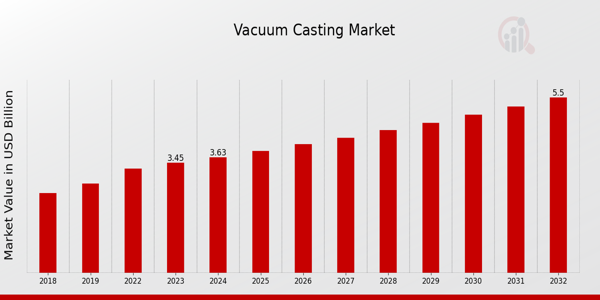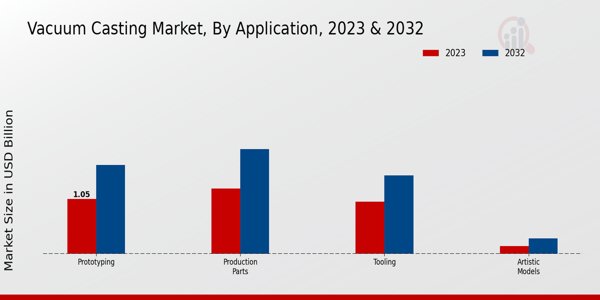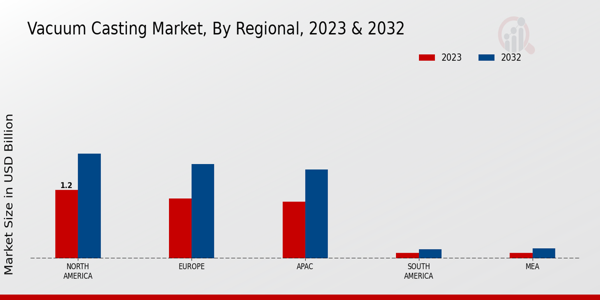Global Vacuum Casting Market Overview
The Vacuum Casting Market Size was estimated at 3.82 (USD Billion) in 2024. The Vacuum Casting Industry is expected to grow from 4.03 (USD Billion) in 2023 to 6.42 (USD Billion) by 2034. The Vacuum Casting Market CAGR (growth rate) is expected to be around 5.3% during the forecast period (2025 - 2034).
Key Vacuum Casting Market Trends Highlighted
The Vacuum Casting Market is witnessing a significant transformation driven by a combination of technological advancements and increased demand for high-quality prototypes. One of the key market drivers includes the growing need for rapid prototyping across various industries, such as automotive, aerospace, and consumer electronics. This method allows for the fast and efficient production of small batches with intricate designs, catering to the fast-paced nature of modern manufacturing. Additionally, the push toward customized solutions has further fueled the adoption of vacuum casting, enabling companies to create tailored products that meet specific customer needs.Opportunities abound in the Vacuum Casting Market, particularly with the rising trend of sustainable production practices. Manufacturers are increasingly looking for ways to reduce waste and utilize eco-friendly materials. This presents an opportunity for companies specializing in innovative casting materials that support sustainability goals. Furthermore, the expansion of industries in emerging markets offers a landscape for growth as businesses seek cost-effective solutions without compromising on quality. The integration of advanced technologies, such as 3D printing, alongside vacuum casting, also presents a unique opportunity to enhance the versatility and efficiency of the manufacturing process.Recently, the market has observed a trend toward increased automation and the application of digital technologies in the vacuum casting process. Automation not only improves production efficiency but also minimizes human error, which is crucial for maintaining the integrity of prototypes. There is also a noted shift toward a more collaborative approach within the industry, as companies partner with material suppliers and technology innovators to develop new products and processes. This collaborative trend is expected to drive further advancements in vacuum casting, ultimately shaping the future of manufacturing across various sectors.

Source: Primary Research, Secondary Research, MRFR Database and Analyst Review
Vacuum Casting Market Drivers
Technological Advancements in Manufacturing Processes
The Vacuum Casting Market Industry is witnessing significant growth primarily due to technological advancements in manufacturing processes. Innovations in materials and casting techniques have made vacuum casting a preferred choice for producing high-quality prototypes and components with intricate designs. This method reduces the risk of defects and ensures high dimensional accuracy, making it ideal for industries like aerospace, automotive, and medical.The adoption of advanced materials such as silicone rubbers and polyurethane elastomers has further enhanced the versatility and applicability of vacuum casting across various sectors. As industries continue to demand higher precision and customized solutions, the technology governing the Vacuum Casting Market is evolving rapidly, ensuring that manufacturers can meet these requirements effectively. The automation of processes related to vacuum casting has also led to improved efficiency and reduced production times, making it an attractive option for businesses looking to scale their operations without compromising on quality.Furthermore, the development of simulation software and 3D printing technologies has streamlined the design and prototyping phases, reducing the time and costs associated with product development. This continuous improvement in manufacturing processes propels the growth of the Vacuum Casting Market as more companies recognize the advantages of integrating these technologies into their production lines.
Increasing Demand for Prototyping in Various Industries
The Vacuum Casting Market Industry is significantly driven by the increasing demand for prototyping across various sectors. As businesses strive for quicker time-to-market and customer-centric product designs, the use of vacuum casting for creating rapid prototypes has gained traction. This demand spans multiple industries, including automotive, electronics, and consumer goods, where fast iteration and testing of designs are critical. By allowing companies to produce high-quality, functional prototypes efficiently, vacuum casting helps validate concepts and make necessary adjustments before full-scale production.
Growth in the Automotive and Aerospace Sectors
The automotive and aerospace industries are key contributors to the growth of the Vacuum Casting Market Industry. With the increasing complexity of designs and the need for lightweight yet durable components, vacuum casting has emerged as a viable solution for manufacturing parts that meet rigorous industry standards. The rise in electric vehicles and innovations in aircraft design are driving demand for precision components made through vacuum casting, reinforcing its importance in these high-tech sectors.
Vacuum Casting Market Segment Insights
Vacuum Casting Market Application Insights
The Application segment of the Vacuum Casting Market represents a vital component of the overall market, which is valued at 3.45 USD Billion in 2023 and is projected to grow to 5.5 USD Billion by 2032. This segment highlights various applications, including Prototyping, Production Parts, Tooling, and Artistic Models, each of which plays a key role in the market’s overall dynamics. Among these, the Prototyping application is particularly significant, holding a value of 1.05 USD Billion in 2023. This segment is essential as it allows businesses to create and test models quickly and cost-effectively, thus driving innovation and speeding up the product development lifecycle.Following closely is the Production Parts application, valued at 1.25 USD Billion in 2023, which dominates the market due to the increasing demand for high-quality, customized production components across various industries. The Tooling application also holds importance, with a value of 1.0 USD Billion in 2023, enabling manufacturers to produce molds and dies efficiently, which is critical for mass production processes. Lastly, the Artistic Models application, while smaller at 0.15 USD Billion in 2023, still holds relevance in niche markets, providing unique opportunities for artists and designers to create prototypes for artistic endeavors.The growth of these applications reflects a broader trend of increasing reliance on advanced manufacturing technologies and the need for rapid prototyping and customization in various industrial sectors. The Vacuum Casting Market is experiencing growth driven by advancements in materials and processes, expanding its applications across multiple industries. However, challenges such as maintaining quality and managing costs remain critical for stakeholders aiming to capitalize on the vast opportunities presented in this segment. The demand for efficient prototyping, custom production solutions, and tooling capabilities serves to shape the future of the Vacuum Casting Market, making the Application segment a focal point for understanding market trends and dynamics.

Source: Primary Research, Secondary Research, MRFR Database and Analyst Review
Vacuum Casting Market Material Type Insights
The Vacuum Casting Market has shown considerable growth, with a projected valuation of 3.45 billion USD in 2023. This market segmentation by Material Type encompasses various categories, notably Silicone Rubber, Polyurethane, Epoxy Resins, and Thermoplastics, each playing a critical role in the broader industry dynamics. Silicone Rubber holds a strong position due to its flexibility, durability, and resistance to extreme temperatures, making it ideal for numerous applications. Polyurethane, recognized for its strength and versatility, significantly contributes to market demands in various sectors.Epoxy Resins are valued for their exceptional adhesion and chemical resistance, making them a preferred choice in industrial applications. Thermoplastics dominate because of their excellent surface finish and ability to be recycled, aligning with current sustainability trends. The demands for innovative materials in manufacturing have driven the Vacuum Casting Market, revealing growth drivers, while challenges such as cost fluctuations and material sourcing remain prevalent. Opportunities for advancements in technology and material efficiencies are likely to shape the future landscape of this segment, offering promising growth potential in the industry.
Vacuum Casting Market Industry Insights
The Vacuum Casting Market is expected to achieve a valuation of 3.45 USD Billion in 2023, with a promising growth trajectory projected to 5.5 USD Billion by 2032. This industry segment plays a crucial role across various sectors, with dominant players including Automotive, Aerospace, Consumer Electronics, and Medical Devices. The Automotive sector significantly benefits from vacuum casting due to its efficiency in producing lightweight components, which enhance fuel economy and performance. In Aerospace, this technology is vital for creating intricate parts that require high precision and reliability, essential for safety and performance.The Consumer Electronics field utilizes vacuum casting for creating shells and cases, which improve the aesthetic appeal and functionality of devices. Meanwhile, Medical Devices rely heavily on this technique for producing high-quality, precise components, ensuring compliance with stringent regulations. The steady demand across these diverse applications drives the Vacuum Casting Market as industries continually seek innovative solutions to enhance product quality and reduce manufacturing costs. With a projected CAGR of 5.33 from 2024 to 2032, the market statistics reflect a robust growth outlook fueled by technological advancements and expanding applications.
Vacuum Casting Market Process Type Insights
The Vacuum Casting Market is projected to witness steady growth, with the market valued at 3.45 USD Billion in 2023. Among the various process types, Low-Pressure Casting, High-Pressure Casting, and Vacuum Injection play integral roles in shaping the industry landscape. Low-Pressure Casting is notable for its efficiency in producing high-quality castings, particularly in the automotive and aerospace sectors, making it a preferred choice among manufacturers. High-Pressure Casting, on the other hand, is critical for its rapid production capabilities and ability to create intricate designs with less material waste, catering to industries like electronics and consumer goods.Vacuum Injection stands out for its precision and ability to work with a range of materials, ensuring minimal air pockets, thus enhancing the final product's quality. The Vacuum Casting Market revenue is expected to reach 5.5 USD Billion by 2032, reflecting the increasing demands and innovation within these process types. As the industry progresses, understanding the Vacuum Casting Market segmentation will be essential for stakeholders to capitalize on market growth opportunities and navigate potential challenges effectively. Market trends show a growing emphasis on sustainability and the need for efficient production methods, driving the adoption of advanced technologies in these process types.
Vacuum Casting Market Regional Insights
The Regional segment of the Vacuum Casting Market is characterized by significant variations in market valuation across different areas. In 2023, the market was valued at 3.45 USD Billion, with North America leading with a value of 1.2 USD Billion, representing a majority holding within the overall market. Europe follows closely with a market valuation of 1.05 USD Billion, while the APAC region accounts for 1.0 USD Billion, demonstrating its significant contribution to the industry. South America and MEA each held smaller shares at 0.1 USD Billion in 2023, highlighting their nascent positions in the vacuum casting market.The expected growth of these regions points to increasing demand for advanced manufacturing techniques and materials. North America’s dominance can be attributed to its robust industrial base and innovation in casting technologies. Europe remains significant due to its strong automotive and aerospace sectors, while APAC’s growth potential stems from rapid industrialization and rising manufacturing activities. Collectively, these insights reflect the diverse landscape of the Vacuum Casting Market, showcasing emerging opportunities and challenges across various regions.

Source: Primary Research, Secondary Research, MRFR Database and Analyst Review
Vacuum Casting Market Key Players and Competitive Insights
The Vacuum Casting Market has garnered significant attention as industries seek innovative manufacturing methods that reduce costs and improve product quality. Competitive insights within this market reveal that companies are increasingly focusing on technology advancements, material development, and customer-oriented solutions to strengthen their market positions. With vacuum casting known for its ability to produce high-quality prototypes and short-run production parts, manufacturers are leveraging these advantages to satisfy diverse customer requirements. The competition is vibrant as players strive to enhance their capabilities and expand their product offerings, aiming to differentiate themselves from others in the industry.GE Additive stands out prominently in the Vacuum Casting Market. The company boasts a robust portfolio that integrates advanced manufacturing techniques with a commitment to quality and innovation. GE Additive leverages its extensive experience in additive manufacturing to enhance vacuum casting processes, thereby increasing efficiency and precision. The company emphasizes the development of strong customer relationships, thanks to its solid reputation for providing tailored solutions that meet specific industry needs. Moreover, GE Additive's investment in research and development allows it to continuously evolve its offerings, remain competitive, and address emerging industry trends, thus ensuring a strong presence in the vacuum casting landscape.3D Systems is another key player in the Vacuum Casting Market, recognized for its pioneering technology and comprehensive solutions tailored to various industries. The company promotes a diverse range of products and services, facilitating a seamless integration of 3D printing and vacuum casting techniques. 3D Systems utilizes its expertise to provide high-quality castings that serve specific applications from rapid prototyping to limited production runs. Their commitment to innovation positions them as a leader in developing new materials and processes that enhance performance and reduce production times. This focus on continual improvement and customer-centric approaches solidifies 3D Systems' status as a notable force within the vacuum casting market, enabling it to adapt to the evolving demands of customers and industries alike.
Key Companies in the Vacuum Casting Market Include
- GE Additive
- 3D Systems
- Stratasys
- Additive Industries
- Protolabs
- Materialise
- Formlabs
- Xometry
- HawkeyePedershaab
- BASF
- Arkema
- SABIC
- DuPont
- Renishaw
- Siemens
Vacuum Casting Market Industry Developments
Recent developments in the Vacuum Casting Market have underscored significant advancements in additive manufacturing technologies. Companies like GE Additive and 3D Systems have been pivotal, emphasizing enhancements in materials that cater to high-precision applications. Stratasys has introduced novel prototypes designed to streamline the vacuum casting process, while Materialise is focusing on optimizing its software solutions, aiding speeds in production. Protolabs has seen growth in demand for on-demand manufacturing, driven by the increasing need for rapid prototyping.On the mergers and acquisitions front, notable movements include Arkema's strategic acquisition of a key competitor, enhancing its material offerings in the vacuum casting space. BASF has also made headlines with its focus on developing more sustainable materials for casting. The combined efforts of these firms have led to a noticeable uptick in market valuations, indicating a robust growth trajectory for participants like Renishaw and HawkeyePedershaab. The urgent demand for lightweight materials in sectors such as aerospace and automotive continues to fuel innovation and expansion in this market segment. SABIC and DuPont are also calibrating their portfolios to meet evolving industry standards and consumer expectations.
- Vacuum Casting Market Segmentation Insights
- Vacuum Casting Market Application Outlook
- Prototyping
- Production Parts
- Tooling
- Artistic Models
- Vacuum Casting Market Material Type Outlook
- Silicone Rubber
- Polyurethane
- Epoxy Resins
- Thermoplastics
- Vacuum Casting Market Industry Outlook
- Automotive
- Aerospace
- Consumer Electronics
- Medical Devices
- Vacuum Casting Market Process Type Outlook
- Low-Pressure Casting
- High-Pressure Casting
- Vacuum Injection
| Report Attribute/Metric |
Details |
| Market Size 2024 |
3.82 (USD Billion) |
| Market Size 2025 |
4.03 (USD Billion) |
| Market Size 2034 |
6.42 (USD Billion) |
| Compound Annual Growth Rate (CAGR) |
5.33(2025- 2034) |
| Report Coverage |
Revenue Forecast, Competitive Landscape, Growth Factors, and Trends |
| Base Year |
2024 |
| Market Forecast Period |
2025 - 2034 |
| Historical Data |
2020 - 2024 |
| Market Forecast Units |
USD Billion |
| Key Companies Profiled |
GE Additive, 3D Systems, Stratasys, Additive Industries, Protolabs, Materialise, Formlabs, Xometry, HawkeyePedershaab, BASF, Arkema, SABIC, DuPont, Renishaw, Siemens |
| Segments Covered |
Application, Material Type, Industry, Process Type, Regional |
| Key Market Opportunities |
Rapid growth in aerospace applications, Expanding automotive industry demands, Increased adoption in healthcare products, Surging demand for prototype development, and Advancements in material technologies. |
| Key Market Dynamics |
Increasing demand for prototypes, Advancements in casting materials, Rise in automotive applications, Growth of the aerospace sector, Demand for customized solutions |
| Countries Covered |
North America, Europe, APAC, South America, MEA |
Frequently Asked Questions (FAQ) :
The Vacuum Casting Market is expected to be valued at 6.42 USD Billion by 2034.
The projected CAGR for the Vacuum Casting Market from 2025 to 2034 is 5.3%.
The Production Parts segment is projected to grow significantly, reaching 2.0 USD Billion by 2032.
The North American Vacuum Casting Market is valued at 1.2 USD Billion in 2023.
Key players include GE Additive, 3D Systems, Stratasys, and Materialise, among others.
The Asia-Pacific Vacuum Casting Market is expected to reach 1.56 USD Billion by 2032.
The Prototyping segment is valued at 1.05 USD Billion in 2023.
The South American Vacuum Casting Market is expected to be valued at 0.16 USD Billion by 2032.
The Tooling application segment was valued at 1.0 USD Billion in 2023.
The MEA Vacuum Casting Market is projected to grow to 0.18 USD Billion by 2032.

















